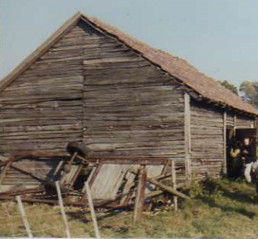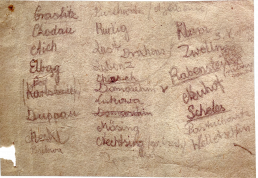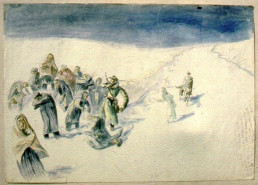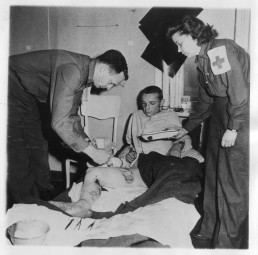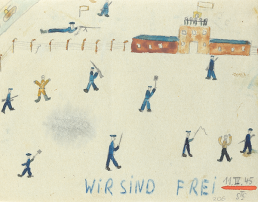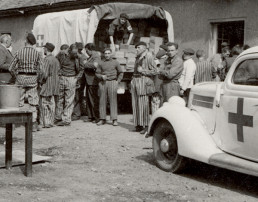Liberated on death marches
As Allied troops approached in early 1945, the SS began to clear the first subcamps of the Buchenwald Concentration Camp, evacuating the prisoners to the main camp or to other camps. In early April, US troops advanced into Thuringia and the SS began evacuating the main camps at Buchenwald and Mittelbau-Dora. Some prisoners were evacuated by rail, but the SS also drove many of the exhausted prisoners on forced marches. Thousands of men, women and children died in the railway wagons, and even more on the death marches.
Some prisoners managed to escape during the evacuation transports. They hid and were liberated by US and Soviet troops.
Death march, escape, hiding. Magda Brown talks about her liberation in March 1945 in an interview, 2014.
Magda Brown (née Perlstein) was born in Miskolc (Hungary) on 11 June 1927. At the age of 17 she was deported to the Auschwitz Concentration Camp, then later that same year she was transferred to the Münchmühle subcamp as a forced laborer in an explosives factory in Allendorf, Hesse. The SS cleared the camp in March 1945, and the prisoners were marched to Buchenwald. During the march, the young woman managed to escape. She and 20 other women hid in a barn, where they were liberated by US soldiers.
(private property/magdabrown.com)
Photo of the barn where Magda Brown and other prisoners from the Buchenwald subcamp Münchmühle hid in 1945, after 1945.
After a day and a half in hiding, Magda Brown and the other women were discovered and liberated by two soldiers from the US Army’s 6th Armored Division.
(private property/magdabrown.com)
"No one yet understands that we have been left behind. There is really no one guarding us anymore! Halina and some girls decided to go to the village [...]. In the clearing lie the sick and weak women in blue-grey striped prisoners' clothes, the color of which clashes with this spring-like fresh green.
The girls return [...]. They are happy, smiling, screaming, crying with joy. THE END OF THE WAR!!! These most glorious words fall unexpectedly and gives strength.
The women run in different directions. They are free, free at last. I don't believe it yet. How did this happen? 'The Soviet army is in the village, we talked to the soldiers,' says a female comrade."
Maria Brzęcka recalls her liberation by Soviet soldiers on 5 May 1945, circa 1990.
Maria Brzęcka and her sister Halina were driven on a death march from the Meuselwitz subcamp toward the Czech Republic in mid-April 1945. Maria, who was completely exhausted, turned 15 while on the march. Shortly before reaching Prague, the SS guards ran off and the prisoners were free.
(Als Mädchen im KZ Meuselwitz – Erinnerungen von Maria Brzęcka-Kosk, Dresden 2016)
Notes written by Maria Brzęcka while on the death march, April/May 1945.
Maria Brzęcka noted the stations of the death march from Meuselwitz towards Prague.
(Buchenwald Memorial)
"Death March," watercolor painting by Polish-Jewish artist Walter Spitzer, 1945.
Walter Spitzer was born in Cieszyn on 14 June 1927. Deported from Poland, he arrived in Buchenwald on 10 February 1945 after a death march from Auschwitz via the Groß-Rosen Concentration Camp. The SS sent the 17-year-old on another death march on 7 April 1945. He managed to escape, and US soldiers liberated him near Jena.
(Ghetto Fighters’ House – Beit Lochamei HaGeta’ot)
US medical personnel treat an 18-year-old Soviet survivor of the Gardelegen massacre, April 1945.
SS members, Luftwaffe soldiers, and members of the Volkssturm and Reich Labor Service set a barn on fire on the outskirts of Gardelegen, murdering more than 1,000 concentration camp prisoners during the night of 13-14 April 1945. They were stranded in Gardelegen while on death marches from the Mittelbau-Dora Concentration Camp and camps in Hanover. Among those murdered were about 100 adolescents ; three sixteen-year-olds are known by name. Only a few prisoners survived the massacre.
(NARA)
Liberations
Liberated in Buchenwald and Mittelbau Dora
In the fall of 1944, the SS began to clear the camps in the east. Tens of thousands of prisoners arrived at Buchenwald and Mittelbau-Dora on evacuation transports from Auschwitz and…
Life in the liberated camp
Many liberated prisoners were in a deplorable condition. Some were more dead than alive. Despite self-sacrificing help from US medics and civilian helpers, hundreds of people still died…
